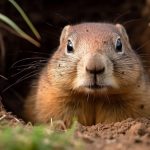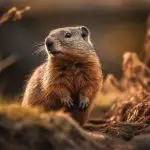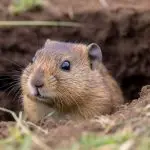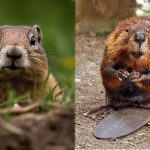What Does a Gopher Look Like? A Comprehensive Guide to Gopher Appearance
Gophers, small burrowing rodents known for their distinctive tunneling, are found throughout North America. They can be a nuisance to homeowners, gardeners, and landscapers, causing extensive damage to gardens, lawns, and crops.
Understanding gophers’ physical appearance and behavioral traits is crucial for effective pest control and wildlife management. You can take the necessary steps to prevent gophers from damaging your property by identifying these characteristics.
So, now you know the importance of knowing its appearance. But, what does a gopher look like? Well, a gopher is a small, stocky rodent with a characteristic appearance. Its size ranges from 5 to 14 inches, typically weighing between 4 and 18 ounces. Its body is cylindrical and covered in dense fur, which varies in color depending on the species and its habitat.
Here, we will provide all the information you need about gophers, including their physical appearance, identifying characteristics, and habitat preferences. We will discuss the different types of gophers, their burrow systems, and how their feeding habits impact your lawn and garden.
Gopher Physical Appearance
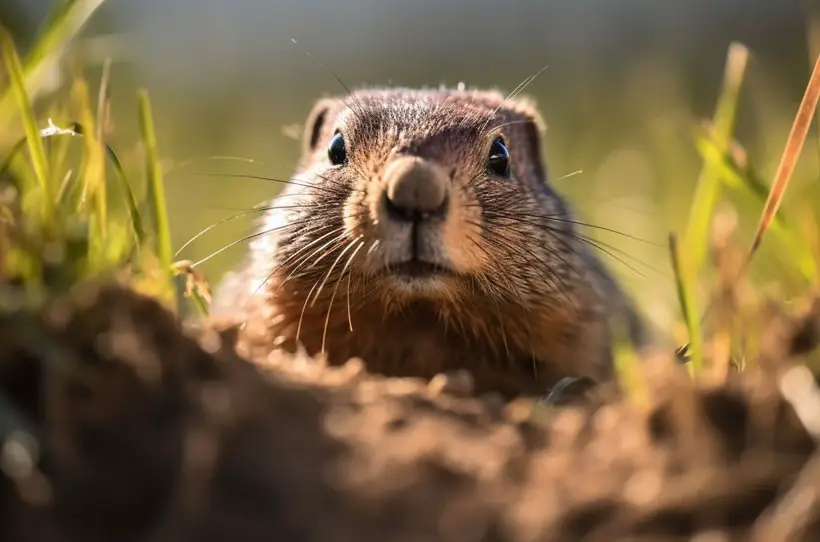
Here is how you can tell the rodent you have seen is a gopher:
1. Size
The size of a gopher varies depending on the species, with some species being more significant than others. Pocket gophers, for example, can grow up to 14 inches in length, while the Botta’s pocket gopher is more minor, measuring around 6 to 10 inches in length.
Gophers have stout bodies and short tails, which they use to maintain balance while burrowing.
2. Fur Color
The color of a gopher’s fur can vary depending on the species and the environment in which they live. Some standard colors include brown, gray, and black. The color of their fur provides camouflage and allows them to blend in with their environment.
3. Body Shape
Gophers have a stocky, cylindrical body shape, with a broad head and short legs. Their body shape is ideal for burrowing through the soil, and their broad head and strong jaws allow them to dig through tough dirt and roots.
Here is a video to help you differentiate gophers from other similar rodents:
Identifying Characteristics
Gophers have several identifying characteristics that differentiate them from other rodents. These include their teeth, claws, and fur.
- Teeth: Gophers have sharp, chisel-like teeth that are constantly growing. They use these teeth to gnaw on roots and other plant material and excavate burrows.
- Claws: Gophers have sharp, curved claws on their front feet for digging and burrowing. These claws are also used for grooming and self-defense. Their strong, sharp claws allow them to move quickly through soil and to excavate complex burrow systems.
- Fur: Gophers have dense fur that covers their entire body, which helps to protect them from the elements and provides insulation. The texture and color of their fur can vary depending on the species and the environment in which they live.
Comparison of Different Species

There is 41 species of gophers, each with unique physical characteristics. Here is a table with a comparison of the most popular gophers only:
| Species Name | Size | Habitat | Distribution |
|---|---|---|---|
| Geomys | 6-8 inches | Grasslands, meadows, forests | Eastern United States |
| Botta’s pocket gopher | 6-10 inches | Agricultural fields | Western North America |
| Northern pocket gopher | 6-8 inches | Grasslands, meadows | Northern United States |
| Southern pocket gopher | 7-9 inches | Desert regions | Southern United States |
| Giant pocket gopher | 8-10 inches | Coastal grasslands | Pacific coast of North America |
| Western pocket gophers | 5-10 inches | Varies depending on species | Western North America |
| Heterogeomys | 6-8 inches | Forests, grasslands | Central America, Mexico |
| Cratogeomys | 6-8 inches | Rocky or sandy soil | Western North America |
| Yellow-faced pocket gopher | 5-8 inches | Grasslands, meadows | Western United States |
| Hispid pocket gopher | 6-9 inches | Grasslands, prairies | Central and Southern United States |
| Pappogeomys | 6-8 inches | Grasslands | Mexico |
Behavioral Traits of Gophers

Understanding these behaviors can help prevent them from damaging gardens and landscapes:
1. Foraging Habits
Gophers are herbivorous rodents that feed on roots, bulbs, and tubers of plants. They consume the entire plant, including the leaves and stems, and are especially fond of succulent plant roots. Gophers can consume up to 60% of their body weight each day, making them voracious eaters.
2. Burrowing Habits
Gophers are known for their burrowing habits, which can destroy lawns, gardens, and landscapes. They dig complex tunnel systems that can be several feet deep and extend over large areas. The burrow systems include feeding tunnels, main runways, and nesting chambers.
3. Gopher Food Preferences
Gophers have a high metabolic rate, which means they need to feed frequently to survive. They are active throughout the year, but their feeding habits can change depending on the season.

In the spring, gophers feed on newly sprouted plants and bulbs; in the fall, they consume mature plant roots and tubers.
Gophers are selective eaters and often feed on plants rich in carbohydrates and starches. They have strong jaws and teeth, which allow them to chew through tough plant material. Gophers also have large cheek pouches to carry food back to their burrows.
Comparison of Gopher Burrow Systems and Impact on the Environment
Gophers have complex burrow systems that vary depending on the species and location. Here is a comparison:
| Gopher Species | Burrow System Characteristics | Impact on Landscaping and Plant Damage |
|---|---|---|
| Botta’s pocket gopher | Simple burrow system with a single main tunnel and a few shorter tunnels branching off | Damage to small trees and shrubs near burrow entrances |
| Northern pocket gopher | Complex burrow system with many interconnecting tunnels and chambers | Extensive damage to large areas of lawn, garden beds, and orchards |
| Southern pocket gopher | Similar to the northern pocket gopher with a complex burrow system | Significant damage to agriculture, vineyards, and orchards |
| Giant pocket gopher | Large burrow systems with multiple entrances and chambers | Major damage to large areas of crops and grasslands |
| Western pocket gophers | Simple burrow system with a single main tunnel and a few shorter tunnels branching off | Damage to small trees and shrubs near burrow entrances |
| Yellow-faced pocket gopher | Complex burrow system with many interconnecting tunnels and chambers | Extensive damage to large areas of lawn, garden beds, and orchards |
| Hispid pocket gopher | Simple burrow system with a single main tunnel and a few shorter tunnels branching off | Damage to small trees and shrubs near burrow entrances |
| Pappogeomys | Complex burrow system with many interconnecting tunnels and chambers | Significant damage to agriculture, vineyards, and orchards |
Habitat Preferences
Understanding the habitat preferences of gophers is essential to managing their populations effectively. Gophers are native to North America and are found in various habitats as shown below:

Areas gophers like:
- Grasslands and prairies
- Agricultural fields
- Parks and open spaces
- Suburban areas with well-manicured lawns
- Woodlands with a mix of grass and forested areas
Areas gophers don’t like:
- Wetlands or swampy areas with standing water
- Heavy clay soils that are difficult to dig through
- Areas with large rocks or roots that make burrowing challenging
- Urban areas with a lot of pavement and concrete
- Areas with high levels of foot or vehicle traffic
Impact of Human Activity on their Habitats
Human activity significantly impacts gopher habitats. As human populations expand, natural habitats are destroyed or fragmented, forcing gophers to adapt to new environments.
These backyard pests can also be affected by agriculture, grazing, and other land uses. For example, when land is converted from natural habitat to agricultural use, gopher populations may decline due to soil types and vegetation changes.
In addition, gophers can cause damage to human-made structures and infrastructures. Their burrowing activities can weaken roads, buildings, and other structures, leading to costly repairs. As such, gophers are often considered garden pests and may be targeted for removal or control measures.
If you’re dealing with gophers in your yard and want to learn more about how to control them, you might be interested in our articles on how to set a gopher trap and chipmunk vs gopher. Our piece on how to set a gopher trap provides a step-by-step guide to catching these pests, while our article on chipmunk vs gopher offers a comparison between these two rodent species.FAQs
Here are answers to common questions for this topic:
Q: What is the Lifespan of a Gopher?
The lifespan of a gopher varies depending on the species and other factors such as predation and disease. On average, gophers can live up to three years in the wild. However, some species have been known to live up to five years.
Q: How do Gophers Mate and Reproduce?
Gophers are solitary animals, but they do mate and reproduce. The breeding season for gophers typically occurs in late winter or early spring. The male gopher will locate a female’s burrow and engage in courtship behavior. After mating, the female will give birth to a litter of 5-6 young. Gophers can have 1 to 3 litters per year depending on various environmental factors.
Q: How Can I Prevent Gophers From Damaging My Lawn and Garden?
Some effective pest prevention methods include using gopher-proof fencing and installing wire mesh baskets around the base of plants. Others include planting gopher-repelling plants and using predators like cats and dogs.
You can also use other traps or baiting stations. Remove any food sources, such as plants that gophers like to eat, and maintain a clean and tidy yard. If all these fail to work, try out the services of pest control companies.
Conclusion
This article has answered questions about “what does a gopher look like?” Gophers are fascinating creatures that burrow through soil and feed on plant roots. Understanding what a gopher looks like is crucial for effective pest control and wildlife management. Typically, gophers range in size from 5 to 12 inches long and can weigh up to a pound. Their distinguishing features are brown or gray fur, sharp teeth, and strong claws.
Gophers prefer to live in dry, sandy soil and can be found in grasslands, pastures, and agricultural fields. Additionally, they are also known to inhabit suburban areas, parks, and gardens, and their presence can have significant effects on the surrounding ecosystem. To prevent gopher damage in gardens and lawns, physical barriers, repellents, and trapping methods can be used. You can also introduce their predators to the affected area to reduce their populations.
Further research is needed to gain a better understanding of gopher behavior, habitat preferences, and their impact on ecosystems. By continuing to learn about gophers, we can work towards reducing the negative impact of gophers on our gardens, lawns, and ecosystems. Ultimately, understanding what a gopher looks like is just one piece of the puzzle in managing and conserving these fascinating creatures.

